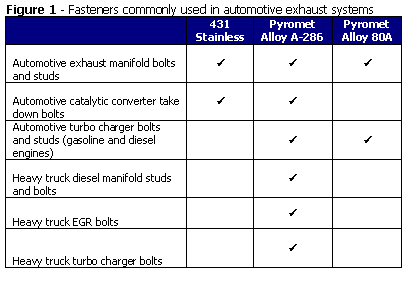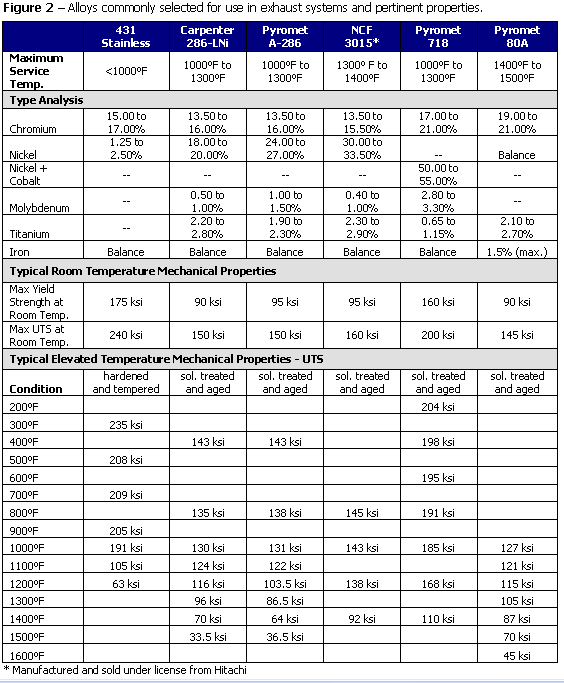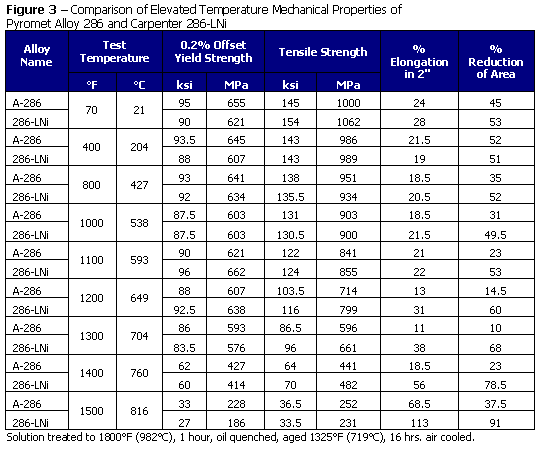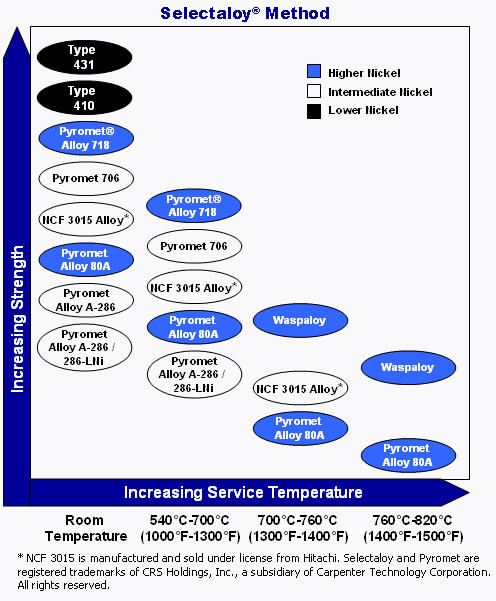Selecting High Temperature Alloys for Fasteners in Automotive Exhaust Systems
Technical Guide
More than ever, alloy choice for fasteners used in automotive exhaust systems is pivotal in meeting today’s increasingly difficult warranty requirements for performance and durability... at an affordable cost.
As emission requirements become more stringent, engines are required to run hotter and more efficiently. In order to ensure optimum performance, bolts, studs and other fasteners that join the exhaust manifold to the engine block are expected to provide a leak-free interface. Additionally, there is an emerging need for high temperature studs and bolts to be specified for joining the catalytic converter and other components. The smallest exhaust gas leak through the joints and sealing surfaces of the exhaust system can jeopardize the integrity of the vehicle emissions system, adversely affect vehicle drivability, and risk being out of compliance with warranty.
Higher efficiency engines today and beyond will tax the already strong demand on the heat resistance of bolts and studs. In many vehicles, the addition of a turbocharger to the engine requires high-temperature-resistant fasteners. Ideally, the joints and unions provided by quality fasteners should last the lifetime of the vehicle.
Direct injection technology is becoming more widespread where combustion efficiency, and the resultant improved fuel economy, is increasingly important. In high pressure direct-injected engines, fuel is injected under high pressure directly into the combustion chamber instead of the intake manifold, with zero tolerance for leakage.
While this fuel delivery system is not subjected to the high temperatures of the exhaust fasteners, many fittings and cold formed components are made from stainless steels, which also must meet very high quality standards and offer a leak-free joint. Direct injection efficiencies will be much more sensitive to fuel system integrity than conventional fuel systems. Bolting materials that may have been considered borderline in the past will now be insufficient to ensure a leak-free joint that will minimize emissions and increase fuel economy of the HP direct-injected engines. Any compromise in exhaust efficiency will offset potential gains of the direct-injected engine.
EPA requirements for emissions and fuel economy, along with the trend toward more powerful and efficient engines for cars and trucks alike, have driven demand for fastener alloys with high temperature capabilities.
Applications and Alloys
Alloy selection guidelines are presented here for the following types of automotive fasteners currently manufactured (Fig. 1): exhaust manifold bolts and studs, catalytic converter take-down bolts, turbo charger and turbo diesel bolts and studs, heavy truck diesel manifold studs and bolts, heavy truck EGR bolts and heavy truck turbo charger bolts. Note that Carpenter Technology A-286 is used for a wide variety of bolting applications. The alloy is commonly used for fasteners requiring high strength and corrosion resistance in temperatures up to 1300ºF (700ºC). It combines high strength at elevated temperatures with an intermediate Ni level, between Carpenter Technology 431 stainless and Carpenter Technology 80A alloy. This combination makes it an appealing alloy for a variety of exhaust bolts.

The alloys most commonly used for the above-listed fasteners, as well alloys with even higher strength at elevated service temperatures are identified in Fig. 2 with their maximum service temperature range, chemical composition, maximum yield and tensile strengths at room temperature, and typical UTS at various elevated temperatures.
Alloys evaluated for these fastener applications are Carpenter Technology 431 stainless, Carpenter Technology 286-LNi alloy, Carpenter Technology A-286 alloy, Carpenter Technology NCF 3015* alloy, Carpenter Technology 718 alloy and Carpenter Technology 80A alloy.
* Manufactured and sold under license from Hitachi

Standard Exhaust System Alloys
Carpenter Technology 431 stainless
Carpenter Technology 431 stainless has the least resistance to high temperatures (up to 1,000ºF or 540ºC) of any alloy in the group. It most likely would be the alloy of choice when advancing from a carbon or lower grade stainless steel. This alloy is the lowest cost of the family discussed here.
Carpenter Technology A-286 Alloy
Carpenter Technology A-286 alloy alloy was used originally in the aerospace industry and can be considered for service at temperatures of 1,000 to 1,300ºF (537 to 700ºC). This alloy is an optional choice for fasteners that require more high temperature capabilities than Type 431 can provide. Alloy A-286 has also been designated frequently to meet the more recent requirements for emissions in diesel trucks and cars. The standards for leak-free exhaust joints, already beyond the capability of carbon steel fasteners, are expected to become even tougher if rising international requirements in the years 2010 and 2011 are to be met.
Carpenter Technology 286-LNi Alloy
Carpenter Technology 286-LNi alloy is a lower nickel variation of Carpenter Technology A-286 alloy. When fastener cost is a consideration, the lower nickel LNi alternative alloy (19% Ni approx.) for Carpenter Technology A-286 alloy (25% Ni approx.) can produce significant raw material savings. Ongoing functional and durability testing has indicated that the Carpenter Technology 286-LNi alloy performs as efficiently as Carpenter Technology A-286 alloy with no loss of heat resistance or creep strength. Properties of the two alloys are displayed in Fig. 3. Both Carpenter Technology A-286 and Carpenter Technology 286-LNi are viable candidates for any of the fasteners commonly produced for automotive exhaust systems.

Higher Temperature Alloys
NCF 3015 Alloy
For service in the temperature range of 1,300 to 1,400ºF (700 to 760ºC), Carpenter Technology NCF 3015 alloy can be considered. This alloy, containing approximately 30% nickel, can be considered as an upgraded alternative to either A-286 alloy or Carpenter 286-LNi for use at slightly higher temperatures (see Fig. 2). NCF 3015 alloy also has been used as a lower cost option for applications which were specified using Pyromet® Alloy 718. The high temperature strengths and oxidation resistance of these two alloys are very similar. The cost benefits of using NCF 3015 alloy, versus Pyromet® Alloy 718, are obvious based on the leaner alloy content of NCF 3015 alloy.
Pyromet® Alloy 718
Pyromet® Alloy 718, with combined nickel and cobalt content of 50.00 to 55.00%, has been used for fasteners that must function at temperatures of 1,000 to 1,300ºF (537 to 700ºC). This is a precipitation-hardenable alloy that possesses exceptionally high yield, tensile and creep rupture properties up to 1,300ºF. It has been used widely for high-temperature bolts and fasteners in the airframes of jet aircraft and in wheels, buckets and spacers.
Pyromet® Alloy 80A
For service at temperatures of 1,400 to 1,500ºF (760 to 820ºC), the materials engineer can consider Carpenter Technology 80A alloy. This high-nickel alloy offers excellent creep strength and oxidation resistance along with high fatigue resistance under critical conditions. It has been widely used for aircraft gas turbine engine components and diesel engine valves. Carpenter Technology 80A alloy has been used frequently by automotive manufacturers in Europe for diesel-powered passenger cars, when higher strength at elevated temperatures than Carpenter Technology A-286 alloy is required.
The importance of excellent high-temperature properties cannot be overemphasized. There is clear evidence that fasteners made from carbon steels, which lack temperature-resistant properties, cannot provide lasting performance for fasteners in the hotter automotive exhaust system.
Flange-fastening bolts, for example, must provide leak-free joints while maintaining constant pressure on those joints as they stretch and yield during service at high temperatures. Those bolts may be torqued at 125 ft. lbs. to provide a tight and lasting seal. At the high operating temperatures of today’s high-horsepower engines, both high yield strength and oxidation resistance are important considerations in alloy selection.
Selection Method
Carpenter has developed a Selectaloy® method to simplify the selection of alloys that can be used for fasteners in automotive exhaust systems. Two general criteria are provided as the basis for selection – service temperature and strength. The diagram (Fig. 4) allows the reader to select the most likely alloy based on the combination of properties that are needed for the application.

Service temperatures increase along the horizontal axis from left to right. Carpenter Technology 80A alloy is generally recommended for service in the highest temperature range.
Strength increases along the vertical axis from bottom to top. Here, Carpenter Technology 431 stainless offers the highest strength, but in the lowest temperature range (room temperature).
Obviously, no single alloy possesses both the highest strength and the best high-temperature capabilities. Most choices, consequently, are based on what appears to be the most appropriate combination of attributes required for a given application.
As indicated by the diagram, some alloys are designated for use at several different combinations of strength and service temperatures. Carpenter Technology 80A alloy, for instance, has been used in four temperature ranges depending on the strength level needed.
Carpenter Technology NCF 3015 alloy is positioned for service in three temperature service ranges and at three strength levels; and CarTec A-286 alloy, with its Carpenter Technology 286-LNi alloy variation, are earmarked for use in two service temperature ranges at three strength levels. Carpenter Technology 718 alloy can be considered for use at two strengths and two service temperature ranges.
Finally, for applications where cost is a major consideration, all the alloys in their ovals are color coded by nickel content. Red shows higher nickel and, therefore, a higher material cost, white shows intermediate nickel content, and black represents the lower nickel.
* * *
By Tinsley Fehnel, Product Application Metallurgist and Fred McMann, Field Application Metallurgist, Midwest